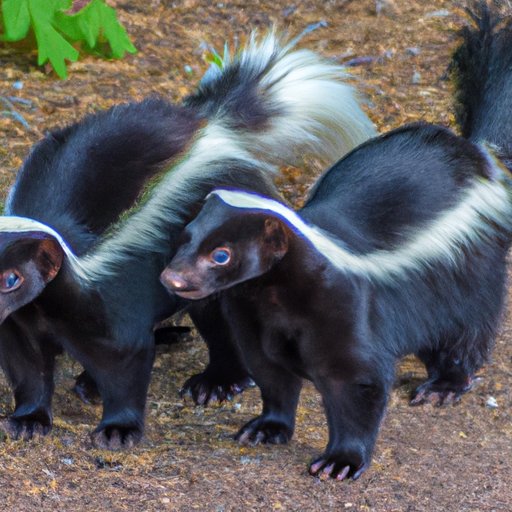Introduction
Skunks are known for their distinct black and white coloration and their ability to spray a pungent odor when threatened. Despite their reputation, skunks are fascinating animals with unique social behaviors. This article aims to answer the question: do skunks travel in pairs? By exploring skunk social behavior, we can gain a better understanding of their conservation needs.
Skunks’ Social Behavior: Do They Travel in Pairs?
To understand whether skunks travel in pairs, we first need to examine their social behavior. Skunks are solitary animals for most of the year, but they do have a social structure. Adults often come together during mating season, and they may also gather in communal dens during the winter. However, skunks typically forage and travel alone.
There are benefits and drawbacks to traveling in pairs for social animals. Pairs can provide social and emotional support, which can increase the likelihood of survival. However, there may also be competition for resources between members of a pair, which can lead to conflict. Additionally, traveling in pairs can make animals more visible to predators.
Research and evidence about skunks traveling in pairs is limited. While some anecdotal observations suggest that skunks may sometimes travel in pairs, there is currently no scientific evidence that supports this idea.
Skunk Social Structure: Family Units and Loose Groups
Skunks have a flexible social structure that can change depending on the time of year and other factors. Some skunks live in family units, which consist of a mother and her offspring. Family units may stay together for several months after the kits are born, but eventually, the young skunks will become independent.
Other skunks may live in loose groups that are not necessarily related. These groups may form around a shared food source or den, for example. However, these groups are usually not permanent and can disband when the resource is depleted or the breeding season ends.
While there is no conclusive evidence that skunks travel in pairs, it is possible that mates may sometimes travel together during the breeding season. However, this behavior may not be consistent across all skunk populations.
Mating Habits of Skunks
Mating season for skunks usually occurs in the late winter or early spring. During this time, males will roam in search of receptive females. When a male finds a female, he may follow her for several days until she is ready to mate. After mating, the male will typically leave the female alone.
While skunks may not typically travel in pairs outside of mating season, pair-bonding can still play a role in mating. Some research suggests that skunks may preferentially mate with familiar individuals, suggesting that some level of social connection may be important for reproduction.
Conservation and Skunk Populations: Implications of Pair Travel
Skunks play an important role in their ecosystems, serving as scavengers and controlling pest populations. However, skunk populations are also under threat due to habitat loss and fragmentation. These environmental changes can impact the social behavior of skunks, including whether they travel in pairs or groups.
If skunks are forced to live in smaller areas due to habitat loss, they may be more likely to form family units or loose groups. This behavior can increase competition for resources, and it may also make them more vulnerable to predators. Additionally, changes in skunk social behavior could impact their role in the ecosystem and their ability to serve as pest control.
Call to Action for Readers to Conserve Skunk Populations
In conclusion, while skunks may not typically travel in pairs, they do have a unique social structure that is important for their survival. Conservation efforts to protect skunk populations should take into account their social behavior and their role in the ecosystem. As individuals, we can support conservation by avoiding the use of pesticides and by advocating for the preservation of natural habitats.
By understanding the social behavior of skunks, we can gain a greater appreciation for these fascinating animals and work to protect them for future generations to enjoy.
(Note: Is this article not meeting your expectations? Do you have knowledge or insights to share? Unlock new opportunities and expand your reach by joining our authors team. Click Registration to join us and share your expertise with our readers.)
